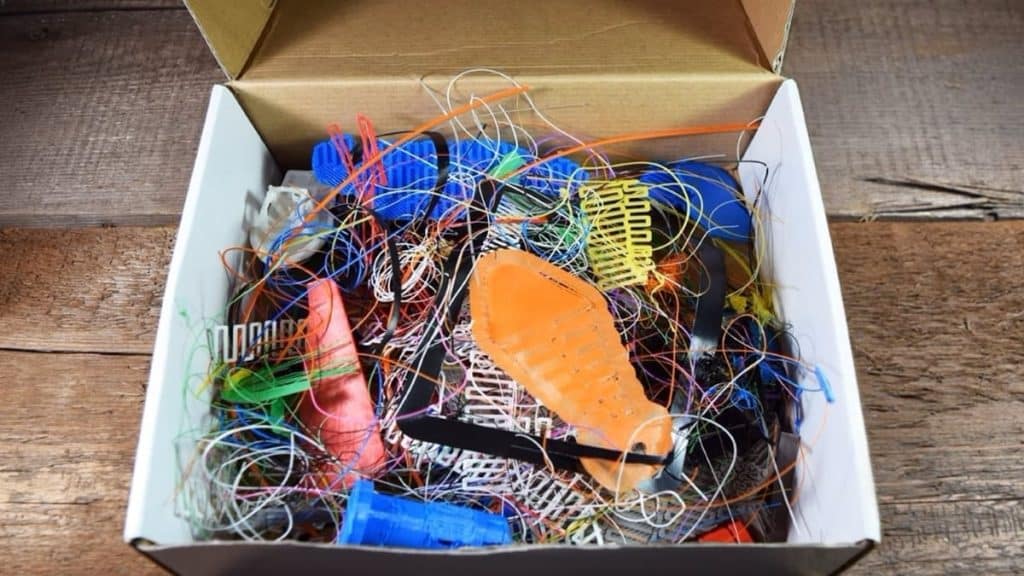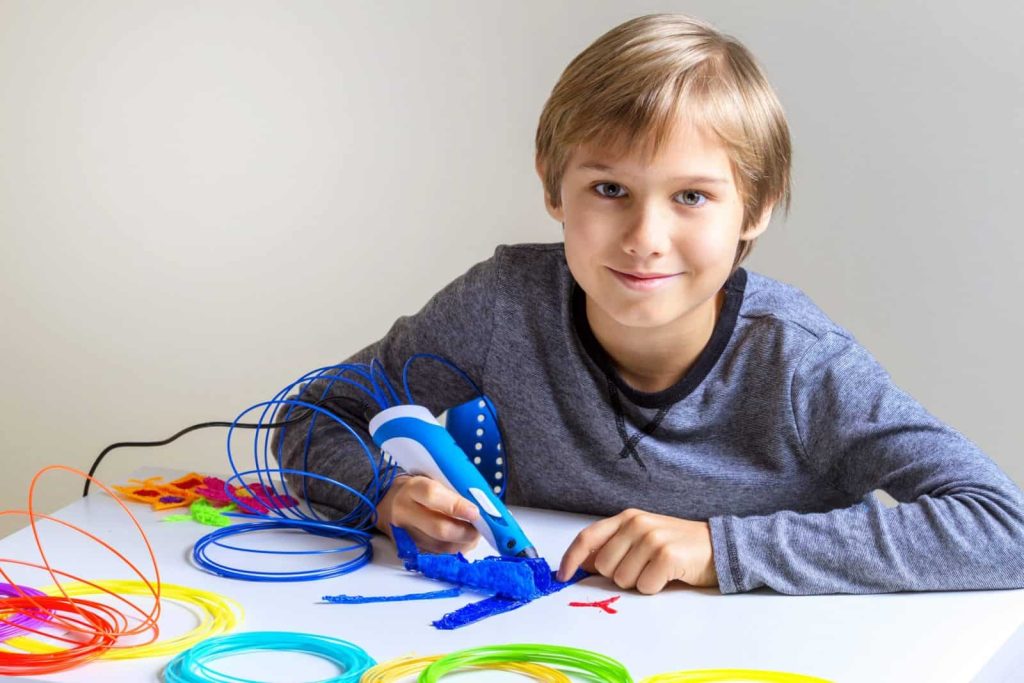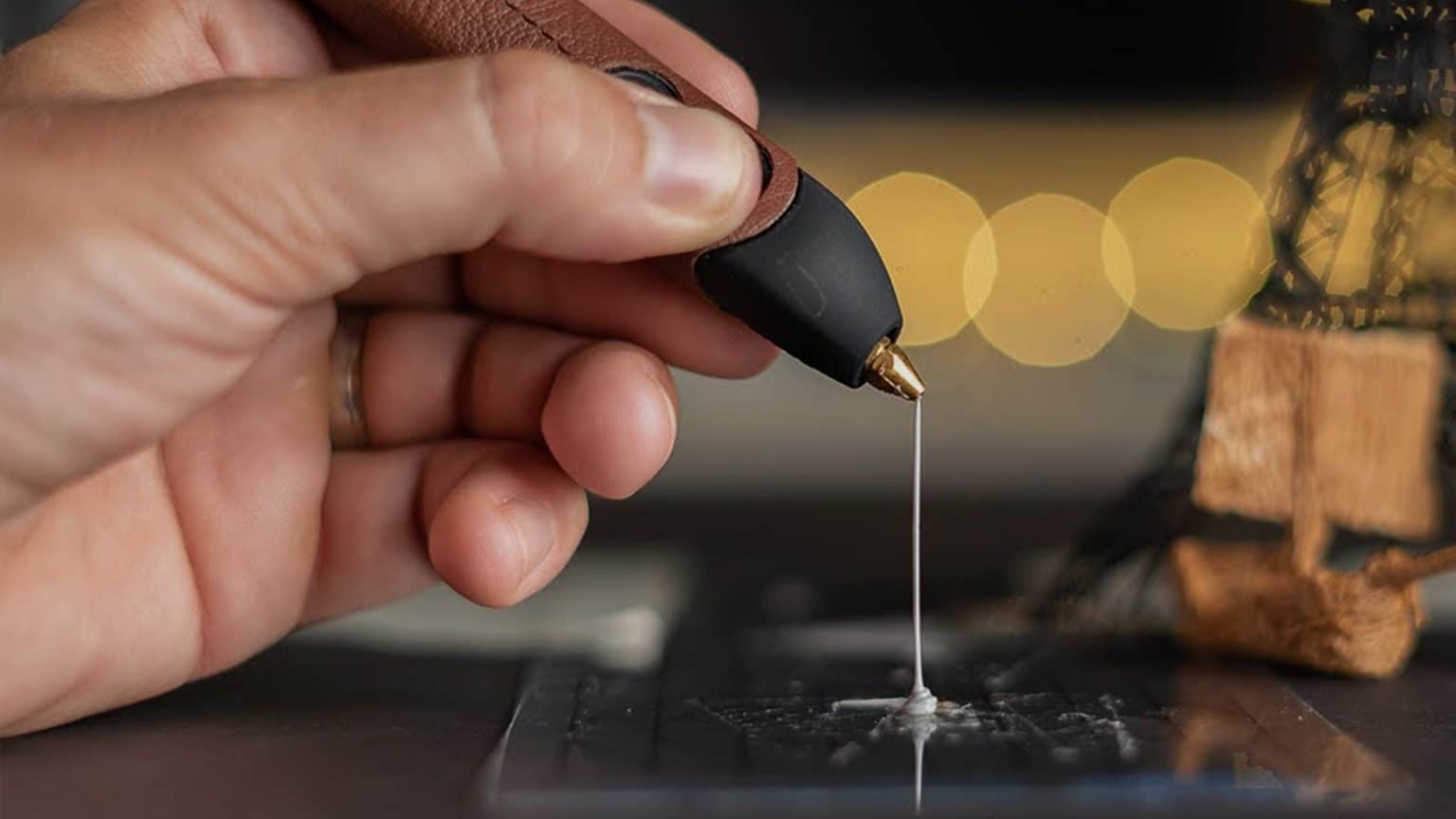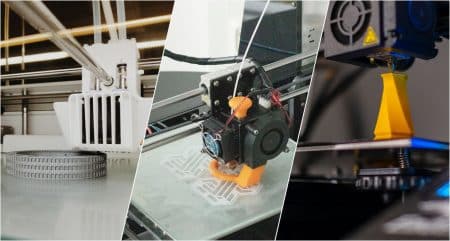3D printing pens are no longer a figment of science fiction. They’re here and transform how we think about art, design, and creativity. But what exactly is a 3D printing pen, and why should you care? Let’s explore this fascinating world together.
What’s a 3D Printing Pen, and Why Should You Care?
A 3D printing pen is like a handheld 3D printer. Imagine drawing something in the air and having it solidify right before your eyes. That’s what a 3D printing pen does. It takes creativity to a whole new level, allowing you to create three-dimensional objects with just a pen and imagination.
Why should you care? Because it’s not just for artists or designers. Whether you’re a teacher looking to make learning more interactive, a hobbyist wanting to explore new mediums, or a professional designer seeking innovative tools, a 3D printing pen offers endless possibilities.
From Sci-Fi to Your Desk: The Journey of 3D Pens
3D printing pens might seem futuristic, but it’s a reality today. It all started with 3D printers, machines that could create three-dimensional objects layer by layer. The idea was revolutionary, but the machines were bulky and expensive.
Enter 3D printing pens. These handheld devices democratized 3D printing, making it accessible to everyone. Now, you don’t need a massive machine or technical expertise. All you need is a pen, some filament (the material used to draw), and creativity.
The journey of 3D pens from a novel idea to a household tool is a testament to human innovation. It’s about making technology accessible, fun, and inspiring.
Unleashing Creativity: Where Can You Use It?

The applications of 3D printing pens are as limitless as your imagination. Here’s a glimpse of where you can use them:
- Education: Teachers use 3D pens to make subjects like geometry and physics come alive. Imagine learning about shapes by creating them in 3D!
- Art and Design: Artists and designers are exploring new dimensions, literally. From sculptures to jewelry, the possibilities are endless.
- Home Improvement: Yes, you read that right! You can use 3D pens to create custom decor or even fix broken objects around the house.
- Healthcare: In some cases, 3D pens are used to create medical models for education and training.
The world of 3D printing pens is vast and growing. It’s not just a tool; it’s a movement empowering people to create, innovate, and explore.
3D printing pens are more than a trendy gadget; they’re a tool for reshaping creativity. They’re making waves across various fields, from education to art, home improvement to healthcare. Whether you’re a curious beginner or a seasoned professional, there’s something in the world of 3D printing pens for you.
How 3D Printing Pens Work: A Peek Inside
3D printing pens are magical, aren’t they? You draw in the air and a solid object forms. But how does this magic happen? It’s not sorcery; it’s technology. Let’s peek into the world of 3D printing pens and unravel the mystery.
Magic or Technology? How 3D Pens Bring Drawings to Life
A 3D printing pen is a marvel of engineering. It’s like a hot glue gun, but way cooler. Here’s how it works:

- Heating Element: The pen heats the filament (usually made of plastic) until it melts.
- Extrusion: As you draw, the melted filament is extruded through the pen’s tip.
- Cooling: The filament cools down quickly, solidifying into a three-dimensional shape.
It’s a simple process, but the possibilities are endless. You can draw in the air, on surfaces, or even on existing objects. The only limit is your imagination.
Filaments: The ‘Ink’ of 3D Pens
The filament is to a 3D pen, what ink is to a regular pen. It’s the material that you draw with. But unlike ink, filaments come in various types and colors. Here’s a quick guide:
- PLA (Polylactic Acid): Made from cornstarch, it’s biodegradable and eco-friendly.
- ABS (Acrylonitrile Butadiene Styrene): Strong and flexible, commonly used in 3D printing.
- Specialty Filaments: These include glow-in-the-dark, metallic, and even wood-like filaments.
Choosing the right filament can make a huge difference in your creations. Experimenting with different types can lead to stunning results.
Safety First: What You Need to Know
3D pens are fun, but they’re not toys. The tip gets hot, and the melted filament can be hazardous. Here’s how to stay safe:
- Read the Manual: Every pen is different. Understand how yours works.
- Use a Heat-Resistant Surface: Protect your workspace from accidental burns.
- Supervise Children: If kids are using the pen, adult supervision is necessary.
- Ventilation: Some filaments emit fumes. Work in a well-ventilated area.
Safety is paramount. With the right precautions, you can enjoy the creative process without worries.
3D printing pens are a blend of art and science. They take a simple concept – drawing – and elevate it to a new dimension. Understanding how they work enhances the experience, allowing you to confidently explore, innovate, and create.
Whether sketching a miniature Eiffel Tower or designing a custom piece of jewelry, the world of 3D pens is your canvas. It’s technology at its most creative, waiting for you to dive in.
Great! Let’s dive into the exciting world of the best 3D pens for 2023.
Best 3D Pens for 2023

The market is flooded with 3D pens, each promising to be the best. But which one is the right fit for you? Whether you’re a newbie exploring this fascinating world or a pro looking for the perfect tool, this guide covers you.
Top Picks, Hot Reviews, and the Ultimate Comparison
Choosing a 3D pen can be overwhelming. There are brands, features, and price points to consider. But don’t worry; we’ve done the homework for you. Here’s a sneak peek at some top picks:
- 3Doodler Start: Perfect for beginners, it’s user-friendly and affordable.
- Mynt3D Professional: A favorite among professionals, it offers precision and control.
- Scrib3D P1: With a display and starter colors, it’s a great all-rounder.
Stay tuned for detailed reviews and a comprehensive comparison table later in this section.
From Newbie to Pro: A Buying Guide for All
Buying a 3D pen is not just about picking the coolest one. It’s about finding the one that fits your needs. Here’s what to consider:
- Skill Level: Are you a beginner, hobbyist, or professional? Choose accordingly.
- Filament Type: Consider the types of filaments the pen supports.
- Features: Look for features like temperature control, speed settings, and ergonomic design.
- Budget: From budget-friendly to high-end, there’s a pen for every pocket.
Remember, the best pen for you is the one that meets your unique needs and creativity.
Creativity at Your Fingertips: Find Your Perfect 3D Pen
Ready to find your perfect 3D pen? Here’s a comparison table to help you:
| 3D Pen | Skill Level | Filament Type | Features | Price |
|---|---|---|---|---|
| 3Doodler Start | Beginner | PLA | User-friendly, Safe for kids | $$ |
| Mynt3D Professional | Professional | PLA, ABS | Precision control, Display | $$$ |
| Scrib3D P1 | All levels | PLA | Starter colors, Project guide | $$ |
This table is just the beginning. Dive into detailed reviews, user experiences, and expert insights to make an informed decision.
3D pens are not one-size-fits-all. They’re as diverse as the people who use them. From children exploring geometry to artists crafting masterpieces, there’s a 3D pen for everyone.
This guide is your roadmap to finding the perfect 3D pen in 2023. It’s not just about the latest trends; it’s about understanding your needs, exploring options, and unleashing creativity.
Tutorials and Lessons: Mastering the Art of 3D Pens

3D pens are not just about drawing in the air; they’re about mastering a new art form. Whether you’re just starting or looking to enhance your skills, tutorials, and lessons are your best friends. Let’s explore how to make the most of your 3D pen.
Basic Drawing Techniques: Start Here
Never used a 3D pen before? No worries! Here’s a step-by-step guide to get you started:
- Choose Your Filament: Pick a color and type that suits your project.
- Heat the Pen: Follow the instructions to heat the pen to the right temperature.
- Start Drawing: Start on a flat surface or in the air, depending on your design.
- Practice Shapes: Try basic shapes like lines, circles, and squares to get the hang of it.
- Create Layers: Build up your design by adding layers.
Remember, practice makes perfect. Don’t be afraid to experiment and learn as you go.
Advanced Modeling Tips: Take It to the Next Level
Ready to go beyond basics? Here are some advanced tips to elevate your 3D pen art:
- Use Stencils: Create or download stencils for intricate designs.
- Blend Colors: Mix different filament colors for a unique effect.
- Add Texture: Use the pen’s tip to create textures and details.
- Repair and Modify: Use the pen to fix or enhance existing 3D prints.
Advanced modeling is about creativity, precision, and innovation. Explore, experiment, and create masterpieces.
Educational Applications: Learning with Fun
3D pens are not just for artists; they’re powerful educational tools. Here’s how teachers and students can benefit:
- Geometry Lessons: Teach shapes and dimensions with hands-on models.
- History Projects: Create historical artifacts and buildings.
- Science Experiments: Model molecules, cells, or even the solar system.
- Art Classes: Encourage creativity and expression through 3D art.
3D pens make learning interactive, engaging, and fun. They bridge the gap between theory and practice, bringing lessons to life.
Tutorials and lessons are the gateway to mastering 3D pens. From basic drawing techniques to advanced modeling, and educational applications to artistic expressions, they offer a roadmap to success.
Whether you’re sketching your first line or crafting a complex sculpture, tutorials, and lessons are your guiding stars. They empower you to explore, innovate, and create with confidence.
3D Pen Stencils and Templates: Unleashing Boundless Creativity

Stencils and templates are to 3D pens what blueprints are to architects. They guide, inspire, and open doors to endless creativity. Whether you’re a beginner looking for guidance or an artist seeking new challenges, stencils and templates are your allies. Let’s dive in!
Free Resources: A Treasure Trove of Inspiration
Why reinvent the wheel when there’s a treasure trove of free stencils and templates online? From simple shapes to intricate designs, here’s where to find them:
- 3Doodler’s Stencil Collection: A vast library for all skill levels. (click here to visit 3Doodler’s shop)
- Thingiverse: A community-driven platform with unique designs.
- Instructables: Step-by-step guides and templates.
Explore, download, and get creative. The world of 3D pen art is at your fingertips.
How to Create Your Own Stencils: Be the Artist
Ready to create your own stencils? It’s easier than you think! Here’s a step-by-step guide:
- Sketch Your Design: Start with a pencil sketch on paper.
- Digitize It: Use software like Adobe Illustrator to create a digital version.
- Print It: Print the design on paper or a specialized stencil sheet.
- Trace It: Use your 3D pen to trace the design, and voila!
Creating your own stencils is empowering. It’s about taking control of your creativity and expressing yourself uniquely.
Community Contributions: Share and Collaborate
The 3D pen community is vibrant and collaborative. Share your stencils, seek feedback, or collaborate on projects. Platforms like Reddit’s 3D Pen Community and Facebook 3D Pen Groups are great places to connect.
Share your passion, learn from others, and contribute to the growing world of 3D pen art.
3D pen stencils and templates are more than guides; they catalyze creativity. They offer a starting point, a challenge, and a canvas to express yourself.
From free resources to creating your own, community contributions to collaborative projects, stencils and templates are the unsung heroes of 3D pen art. They empower you to explore, innovate, and create without boundaries.
Repairing and Modifying 3D Prints: The Art of Fixing and Enhancing

3D pens are not just for creating new art; they’re also powerful tools for repairing and modifying existing 3D prints. Broken a piece of your favorite 3D printed model? Want to add some flair to a bland design? Your 3D pen has got you covered. Let’s explore how.
How to Repair Existing Prints: Fixing Made Easy
Accidents happen, and 3D prints can break. But don’t despair; your 3D pen can fix it. Here’s how:
- Identify the Break: Understand where and how the print has broken.
- Prepare the Surface: Clean and sand the broken edges for better adhesion.
- Heat Your Pen: Choose a filament that matches the original print.
- Weld It Together: Use the 3D pen to ‘weld’ the broken pieces.
- Smooth It Out: Sand and paint if necessary to blend the repair.
Voila! Your 3D print is as good as new; you’ve saved it from the trash bin.
Adding Details and Parts: Enhance with Flair
Your 3D pen is also a tool for creativity and enhancement. Here’s how to add details and parts:
- Create Accessories: Design and attach accessories to existing models.
- Add Textures: Use the pen to create textures and patterns.
- Modify Shapes: Change or enhance shapes to customize the design.
- Blend Colors: Add color accents or gradients for a unique look.
Your 3D pen is like a magic wand, transforming ordinary prints into extraordinary art.
Organic Printing Techniques: Sculpt Like a Pro
Want to take it to the next level? Explore organic printing techniques with your 3D pen:
- Freehand Sculpting: Create organic shapes and forms by drawing freehand.
- Layering: Build up layers to create complex structures and textures.
- Blending: Blend different filaments and colors for a natural look.
Organic printing is about intuition, creativity, and artistic expression. It’s sculpting in the 3D pen world.
Repairing and modifying 3D prints with a 3D pen is an art and a skill. It’s about seeing potential in broken pieces and adding magic to the mundane. From fixing breaks to creating masterpieces, your 3D pen is versatile.
Whether salvaging a cherished print or breathing new life into an old design, your 3D pen is your ally. It’s creativity, innovation, and practicality rolled into one.
Environmental Considerations: 3D Pens and the Planet

3D pens are incredible tools for creativity, but what about their environmental impact? Environmental considerations are essential from the filaments we use to how we dispose of them. Let’s explore how to enjoy 3D pens responsibly.
Bio compostable Options: Green Creativity
Not all filaments are created equal. Some are more eco-friendly than others. Here’s a look at green options:
- PLA (Polylactic Acid): Made from renewable resources like cornstarch, PLA is biodegradable.
- Wood Filaments: Blended with wood fibers, these filaments offer a natural look and feel.
Choosing eco-friendly filaments is a step towards responsible creativity. Look for certifications and labels to ensure authenticity.
Recycling and Waste Management: Reduce, Reuse, Recycle
3D pen art is fun, but what about the waste? Here’s how to manage it:
- Reduce: Use only what you need, and plan your designs to minimize waste.
- Reuse: Repurpose failed or unwanted creations into new art.
- Recycle: Some filaments can be recycled. Check with local facilities.
Waste management is not just about disposal; it’s about mindful creativity and resourcefulness.
Ethical Considerations: Beyond the Pen
Environmental responsibility goes beyond materials and waste. Consider these aspects:
- Energy Consumption: Choose energy-efficient pens and practice energy-saving habits.
- Supply Chain: Consider the environmental impact of manufacturing and shipping.
- Community Engagement: Share knowledge and promote eco-friendly practices within the 3D pen community.
Being an ethical 3D pen artist is about awareness, choices, and community engagement.
3D pens are not just tools for art; they’re part of a broader ecosystem that includes our planet. Environmental considerations are not an afterthought but integral to responsible creativity.
From choosing bio compostable filaments to recycling, energy efficiency to community engagement, every choice matters. It’s about enjoying the magic of 3D pens while honoring our commitment to the Earth.
Frequently Asked Questions (FAQs): All You Need to Know About 3D Pens

3D pens are fascinating, but they also raise many questions. The FAQs cover everything from beginners wondering how to start to experts seeking advanced tips. Let’s answer some common queries and debunk myths.
3D pens are as intriguing as they are innovative. The FAQs offer a glimpse into this world, answering common questions and guiding newcomers and seasoned artists.
Whether wondering how to start or seeking advanced insights, the FAQs are your go-to resource. They demystify, inform, and inspire, opening doors to endless creativity.
The Future of 3D Pens: Emerging Trends and Exciting Horizons
3D pens have come a long way since their inception, but what does the future hold? From technological advancements to new applications, the future of 3D pens is a thrilling frontier. Let’s explore what’s on the horizon.
Next-Gen Technology: What’s Coming?
The technology behind 3D pens is evolving rapidly. Here’s a glimpse of what’s coming:
- Precision Control: Advanced sensors and controls for unparalleled accuracy.
- Multi-Material Support: Pens that can handle a wider range of materials, including metals and ceramics.
- Smart Connectivity: Integration with apps and software for enhanced design capabilities.
- Eco-Friendly Innovations: Sustainable materials and energy-efficient designs.
The future is about pushing boundaries and expanding possibilities.
New Applications and Fields: Beyond Art
3D pens are breaking out of the art studio and into new fields. Here’s where they’re headed:
- Medical Training: Creating anatomical models for education and surgical planning.
- Architecture: Building scale models and prototypes.
- Fashion: Designing and creating wearable art and accessories.
- Space Exploration: NASA has even explored using 3D pens in space!
The applications are as limitless as human creativity and ingenuity.
Education and Community: A Growing Movement
3D pens are becoming powerful tools for education and community engagement:
- STEM Education: Integrating 3D pens into science, technology, engineering, and math curricula.
- Art Therapy: Using 3D pens for therapeutic and expressive purposes.
- Global Community: Connecting artists, educators, and enthusiasts worldwide through online platforms and events.
The future of 3D pens is not just about technology; it’s about people, connections, and shared passions.
The future of 3D pens is an exciting journey into uncharted territories. It’s about innovation, exploration, and human potential. The road ahead is filled with promise, from next-gen technology to new applications, education to community.
3D pens are not just a trend; they’re a movement. They’re reshaping how we create, learn, and connect. The future is bright, and it’s waiting for you to draw it.
Absolutely! Let’s bring it all together with a conclusion that encapsulates the essence of this comprehensive guide.
Conclusion: The 3D Pen Revolution – Join the Movement
3D pens are more than just a tool; they’re a revolution. From humble beginnings to futuristic horizons, they’ve captured the imagination of artists, educators, engineers, and dreamers worldwide.
A World of Creativity
3D pens have democratized creativity, making 3D art accessible to all. From simple doodles to intricate sculptures, they’ve opened doors to a world where imagination knows no bounds.
A Tool for Innovation
Beyond art, 3D pens are finding applications in medicine, architecture, fashion, and even space exploration. They’re not just drawing lines; they’re breaking barriers.
A Commitment to Responsibility
With options for eco-friendly materials and a focus on sustainability, 3D pens are also a testament to responsible creativity. They remind us that innovation and environmental stewardship can go hand in hand.
A Community of Passion
The 3D pen community is a melting pot of passion, collaboration, and inspiration. It’s where beginners learn, experts share, and creativity flourishes.
Join the Movement
Whether picking up a 3D pen for the first time or exploring new frontiers, you’re part of a movement. A movement that celebrates creativity, embraces innovation, values responsibility, and thrives on community.
The 3D pen revolution is here, and it’s just the beginning. The canvas is vast, the possibilities endless, and the future bright. So grab your 3D pen and join the movement. Draw, create, innovate, and inspire. The world is waiting for your art.





